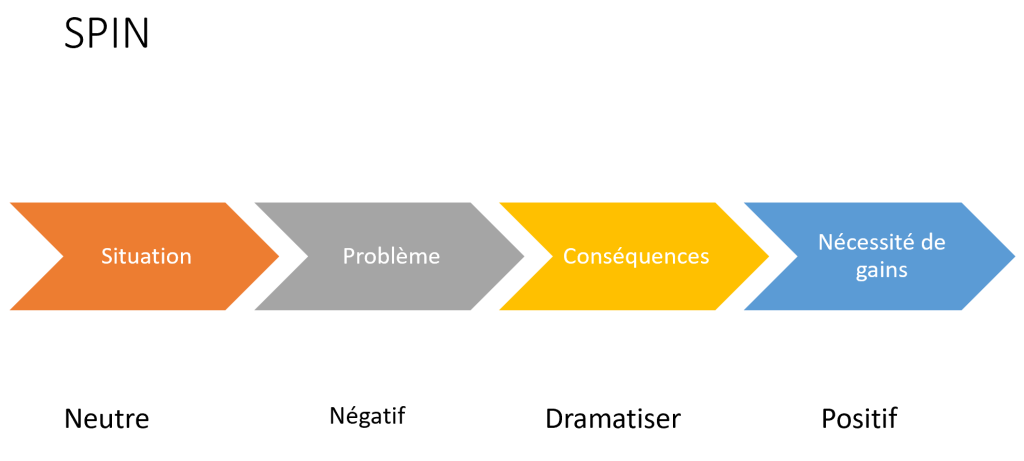SPIN sales technique
The SPIN sales technique originated in the USA, and is based on understanding the customer’s situation, highlighting the problem and its consequences, and then explaining the benefits of our solution. Unlike other methods, such as the CAB technique, the key point here is not to propose a solution before the customer has understood that he […]
The SPIN sales technique originated in the USA, and is based on understanding the customer’s situation, highlighting the problem and its consequences, and then explaining the benefits of our solution. Unlike other methods, such as the CAB technique, the key point here is not to propose a solution before the customer has understood that he has a problem. It takes a little longer, but it’s more efficient.
The SPIN technique

- Situation: understand the customer’s overall situation
- Problem: highlight the problem he doesn’t see
- Involvement: ask about the economic and psychological consequences of the problem
- Needs pay off: present the benefits of your solution
Situation
The customer’s situation is discovered through key questions that you adapt to your customer in order to uncover his or her problem.
For an individual, you can ask questions such as :
- Tell me about yourself
- What situation are you in?
- Which solution do you use?
- What are the advantages and disadvantages for you and your family?
For a professional contact, you can ask the following questions:
- How is your company structured?
- What competition?
- What solutions are used?
- What are the advantages and disadvantages for your department and your employees?
The most important thing in the SPIN method is to master these questions, which must be adapted to the business and the type of contact.
Problem
The information on the customer’s situation enables you to target the customer’s problem, which you’ll be able to highlight at this stage. If you don’t, you’ll have to do it yourself, with the risk of your customer becoming frustrated at being told he’s got problems by someone else, and a salesperson at that!
- What difficulties do you encounter?
- How long does the process take?
- How much does it cost?
- Are you completely satisfied with your current supplier?
Involvement
Involvement aims to deepen the customer’s experience of inconvenience.
- Individual:
- What are the consequences of your frustrations? How do you feel at the end of the day? Does it keep you awake at night?
- For a professional :
- How can you put a figure on lost revenue? What are the losses? What does this mean for your department?
Need for gains
The earnings requirement calculates how much you can earn for your customer:
- Do you agree that our solution will help you?
- How much will you earn?
- What impact will this have on your department?
- What’s the impact on the company’s bottom line?
Here are a few examples of how the SPIN technique is used
I’m not presenting the technique in detail here – you can find it in our online sales courses– but a very simplified version so that you can better understand how it applies.
An example from the beauty sector:
- Situation: What is your current skincare routine?
- Problem: how does your skin feel at the end of the day? Tense? Dry?
- Involvement: do you know what this means for your skin? Did you know that skin is your most important asset and that it represents your age?
- Need to win: do you know how you can rejuvenate your skin with our product? Did you know that you can gain 10 years?
Example of home insurance for tenants:
- Situation: Is your apartment insured?
- Problem: you know you’re responsible even if your landlord has insured it?
- Implication: are you capable of paying $200,000 in the event of fire or water damage?
- Necessity of gain: You want to be 100% guaranteed for a very small sum every month.
As you can see, in some simple sales you can ask a series of closed questions. It’s wrong, and even ridiculous, to say that in sales you should always ask open-ended questions. Instead, you need to know how to alternate them depending on the type of sale.
In conclusion
The SPIN technique is an excellent method that has proved its effectiveness in several studies. However, it has the disadvantage of turning the knife in the customer’s back, and risks leading him to start pushing away the salesperson who tells him he has problems. We prefer the SOS technique, which is more subtle and also plays on the customer’s dreams.
Jean-Pierre Mercier
